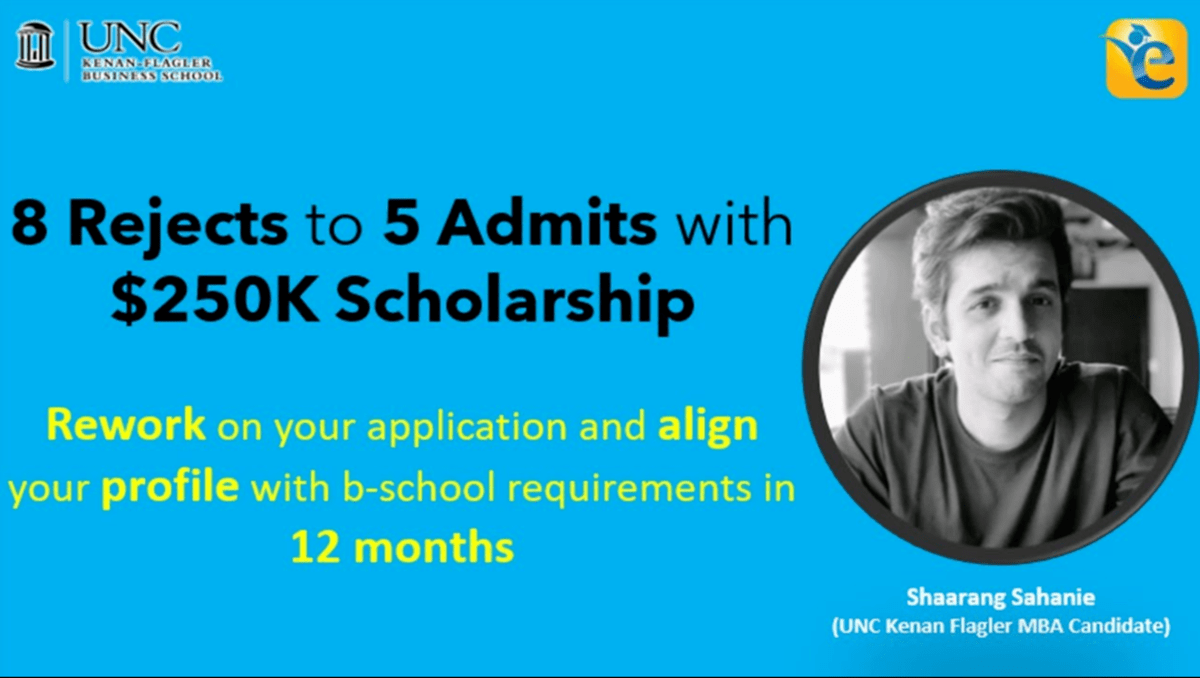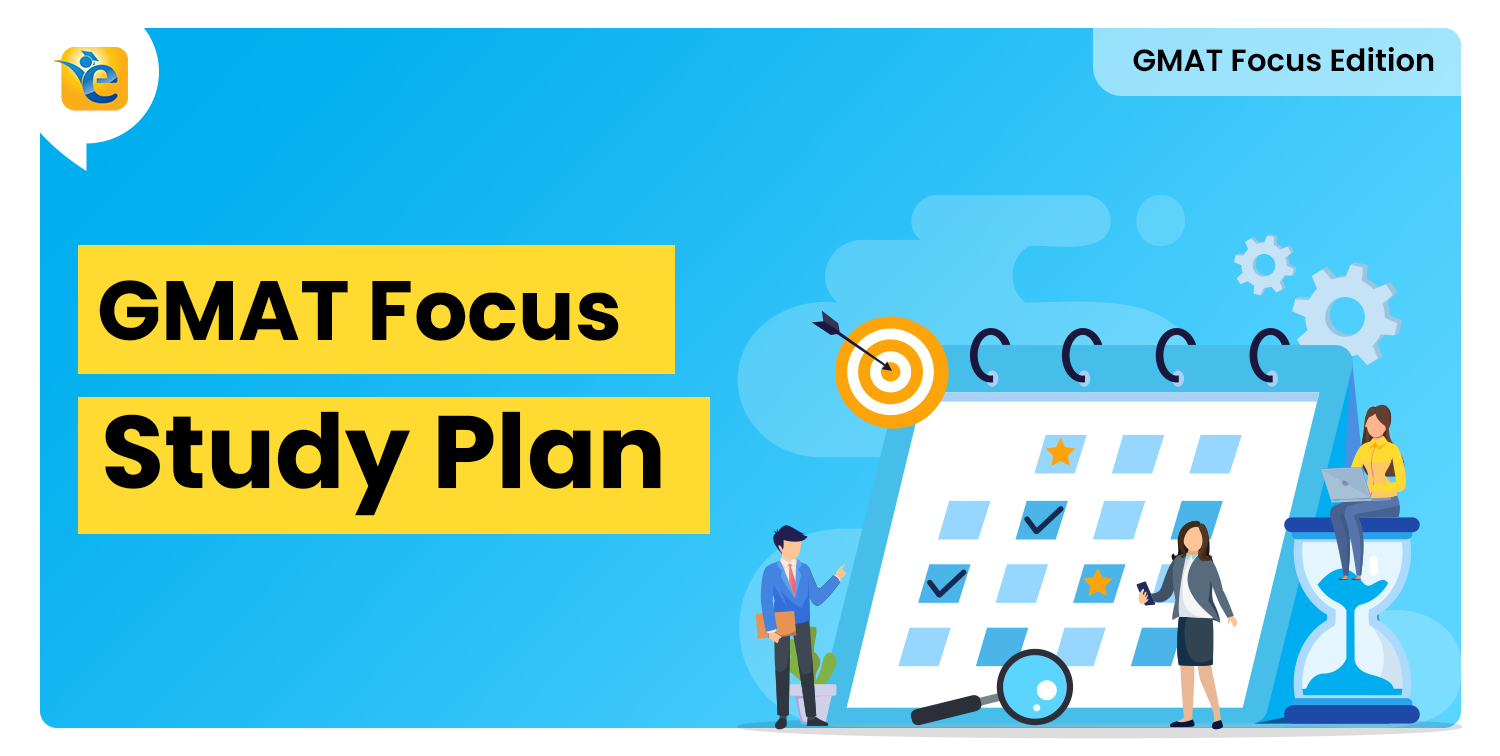Coming from an engineering background, Shaarang had an unconventional and impressive work history. After his undergrad, he worked with an investment bank and simultaneously started his firm (Codebreak – an analytics start-up that delivered tech-enabled advice to retail investors). After gaining almost three years of experience (Investment banking + Entrepreneurship), he decided to apply to business school but got rejected from all eight colleges. Post that, he rebuilt his profile and got into multiple B-schools with about $250,000 worth of scholarships!
How did he do it?
Read this article highlighting the three key steps Shaarang took to get admissions from 5 top business schools with scholarships. The article is based on the Q&A Webinar with Shaarang.
You can also watch this video interview of Shaarang with Rajat, CEO at e-GMAT, to get an overall picture of Shaarang’s MBA Journey and how he got a $250,000 worth scholarship:
3 Key Steps to successfully apply for an MBA
Shaarang scored high on GMAT (GMAT 740), spent a good amount of time(5 to 6 months) on his MBA Application, wrote compelling essays, and had a strong resume. Moreover, his professional background was diverse and unique. So, what went wrong. Why did he get rejected by 8 B-schools?
Shaarang – I realized that the issue was not my GMAT score or my professional background. It was the way I communicated my goals. I realized that I made my admissions officer’s life hard by talking about complicated plans that I was not in a good position to achieve.
I come from a tech + entrepreneurial background, and my post-MBA goal was to pursue a career in Private Equity/Venture Capital. When you look at the employment statistics at any top B-school, only about 2% – 3% of the class goes into this sector. Most of these people typically have an Investment Banking/Venture Capital/Private Equity background pre-MBA. Thus, my goals seemed disjointed.
After getting rejected from 8 B-schools, shaarang reworked his MBA application and aligned his profile with B-school requirements.
Here are the three key steps he followed.
Step 1: Securing a high GMAT Score
Rajat – How did you cross the GMAT 700+ barrier?
Sharaang – I spent about 4.5 months studying from many free resources available like GMAT Official guide and GMAT Club. After 4.5 months, I was able to increase my GMAT score from 560 to 690. However, to cross the 700+ barrier, my preparation required a structure, and there was no sort of data to track my progress and pinpoint my weakness. So, I switched to an AI-driven GMAT preparation course – e-GMAT.
My go-to tool was Scholaranium, which helped me identify my weaknesses sub-topic-wise and target topics that I needed to revisit and build my ability on. As my MBA application deadlines were just around the corner, Scholaranium analytics helped bridge my verbal gap and increased my score from V35 to V42 in just 14 days!
Watch Shaarang’s GMAT preparation journey and how he leveraged the data and analytics offered by the e-GMAT course to score a 740 on the GMAT:
Did you know a high GMAT score can make a stronger case for your application? We can help you with your GMAT preparation. Try out our free trial and get access to free online GMAT prep resources. We are the only GMAT prep company that has delivered more 700+ scores than any other GMAT club partner.
Step 2: Craft a stellar MBA application
After Shaarang realized what went wrong with his previous MBA application, he evaluated his MBA profile and started working on strengthening his weak areas. He focused on four key things:
- Identifying the scope of improvement
- Compensating for a Low GPA
- Crafting a compelling MBA essay
- Having a good recommender
Identifying the scope of improvement
Shaarang – I went through a three-month deep introspection process and looked at all the different components in my application. There were six components:
- Professional experience
- Extracurriculars
- GMAT Score
- GPA
- Essays
- Letter of recommendations
I examined each component, and wherever I felt I was weak, I focused on improving it.
I was super insecure about my GPA. I got 70%, which accounts for 25% of the class. But, when I converted my percentage to the American grading system, it came down to 2.5/4, which is not good. So, GPA was one thing that I needed to strengthen.
Apart from that, even though my leadership essay was on point, my goal-related essay required to be adequately addressed. Besides, I also made a mistake while selecting my recommender. After identifying areas of improvement, I started to rebuild my MBA profile.
Compensating for a Low GPA

Rajat – So, how did you overcome your low GPA?
Shaarang – To overcome my low GPA, I made sure that the admissions committee knew my GMAT 740 was not a fluke and I could survive in a quantitatively rich MBA environment. So, I took the HBx CORe program, a three-month intensive course that teaches you the fundamental skills for business decisions and decision-making. Even though the program was intense, I graduated with Honours, which showed the admissions committee that I could handle the MBA environment.
Read this article to know the importance of GPA in your MBA application and three things you can do to compensate for a low GPA.
Crafting a compelling MBA essay
Rajat – How did you portray leadership in your MBA Application?

Shaarang – Leadership can be covered in multiple sorts of ways. Leadership is overcoming a challenge. You don’t have to be a manager to be a leader. My 2019 MBA application round (before joining e-GMAT) focused on how I overcame challenges and how I worked towards solving them. Whereas, for my 2020 MBA application, my leadership stories were about how I inspired other people to overcome those challenges and how I worked in a team. So, there was a difference in the leadership stories that I portrayed in my MBA application.
My consultant and I also got creative about where to talk about these leadership stories. It’s not just limited to your essays. You can talk about it in your interview, resume, and letter of recommendation.
Rajat – What are some of the mistakes that people make with regard to essays?
Shaarang – You as an applicant have spent months creating this well-crafted application, but an admissions officer has about 10 mins to review it. If you’ve written two essays, just reading and reviewing those takes about five to seven minutes, leaving about 2-3 minutes to check the rest of your application.
So, when you make your story extremely easy to understand and articulate it in 10 minutes, you effectively utilize that time. Your admission officer can understand exactly what you want to do post your MBA, why MBA, and what are your goals? If you provide a covered story, the admissions officer will not have time to dig deep and understand what you’re saying. If your story is not clear, your application might be in the rejection pile.
Having a good recommender
Shaarang – having a good recommender who’s willing to sort of vouch for your latest skills and ready to write a recommendation that talks about those skills are critical.
For my 2019 MBA Application, I made a couple of mistakes. During that time, I had one proper job in investment banking to get a LOR from my manager. I did not have a manager in my entrepreneurial venture, so I took LOR from my co-founder.
A letter of recommendation from a manager vs. peer isn’t always looked at in the same light because there is a chance that you might influence a peer recommendation.
For my 2020 MBA Application, I took one LOR from my manager in the most recent position and one from my manager from an investment banking company.
Here are some tips on getting a perfect LOR.
Rajat – How do you prep people for a letter of recommendation?
Shaarang – It’s very important to prep people for a LOR, especially in India. Writing a letter of recommendation in depth is not a part of our culture. Thus, it is essential to articulate clearly to your manager what’s at stake, how important the LOR is, and the fact that they need to explain in detail what specific tasks you did, which shows the leadership skills. So, it’s a bit of show-and-tell.
Recommenders can’t just say that XYZ has good leadership skills. They need to tell what XYZ has done at their company that inspires them to believe that XYZ is a good leader. It’s essential to go to that detail and write the LOR.
Rajat – It is also essential to understand that the letter of recommendation has quantitative and qualitative components. The quantitative component is where you rate a candidate on various measures like – was Shaarang collaborative, or did he seek out collaboration among different departments. Now, if you are rating someone in a very quantitative fashion but don’t justify it with qualitative examples in the essay questions, those ratings have no meaning. I think that’s where the letter of recommendation is an entity that needs to be in sync with the rest of your MBA application.
Did you know a high GMAT score can make a stronger case for your application? We can help you with your GMAT preparation. Try out our free trial and get access to free online GMAT prep resources. We are the only GMAT prep company that has delivered more 700+ scores than any other GMAT club partner.
Step 3: Transforming MBA profile

Rajat – How did you align your post-MBA goals for the next application round?
Shaarang – When you come from an entrepreneurial background, you have a very broad set of skills. You don’t have specific functional skills, and thus your goals are sort of vague. To transform my profile and align my post-MBA goals with my experience, I started to work for e-GMAT, where I got the flexibility to work with each department and figure out which function I am good at.
Working with e-GMAT helped me to:
- Realize that designing/launching products and collecting customer feedback for improving that product is what I love to do. That’s why I wanted to be a product manager
- Identify problem statements in each department, create a process to solve it, and then streamline the process for future
- Articulate the impact that I have made in a structured manner. When you work for someone, you are forced to put processes around things that you would have figured out randomly in your own company. Establishing those processes helped me better articulate the impact that I’ve created, which was also evident in my MBA interview. For instance, when someone asked me how I launched an application with 10,000 customers, I could take them step by step and explain exactly what I did
Gaining clarity on post-MBA goals
The kind of experiences and processes that Shaarang went through at e-GMAT helped him transform his MBA profile, which was purely entrepreneurship-based.
Shaarang – In the second round of MBA application, my main goal was Product Management at a large tech company. My plan B was operations because my official title was Director of Operations for the duration I worked with e-GMAT. So, my story was as I’ve already done operations pre-MBA, I can get a job in operations post-MBA.
Rajat – How were the interviews this time in terms of admissions committee belief in your post-MBA goals?
Shaarang – Interviews were a lot easier as my goals were now aligned. Having aligned goals is also better for me as a candidate because I don’t have to spend ten minutes out of the 30 minutes interview to justify why my plans make sense. This gives me more time to talk about my amazing accomplishments instead of answering why I think I can get a job as a Project Manager. In fact, the question about why product management didn’t come up in my interview as I had launched 4-5 products before in a start-up situation. Moreover, the transition from start-up product management to a big tech product management company seemed like a natural sort of progression.
How do you choose an admission consultant?
Rajat – What should you look for in an admission consultant?
Shaarang – When you decide on taking advice from an MBA admission consultant, you should look for approachability. The admissions process can get very lonely and scary. Sometimes you will get demoralized when you keep on getting rejects, which will affect your other applications. So, you need an experienced friend in your consultant.
Make sure an MBA consultant is the right fit for you
Shaarang – Typically, you have one free call with the consultant for about 30 minutes. When you have that call and if you feel this is someone you would want to know more about or talk to and take advice from in real life, go with them. You need them to be approachable and care about you to give you the right advice. Also, use their experience rather than using them for writing your essays.
Part-time vs. full-time MBA consultant
Shaarang – Beware of part-time consultants, people who have a day job but consult on the side. When you’re doing consulting on the side, you may not always be in the know of the latest developments in admissions. The consultant I worked with for my 2019 application was working full-time at Deloitte, but he was doing consulting on the side. He had graduated from Chicago Booth, but such top b-school graduates who become MBA consultants are typically five or six years removed from their MBA experience and don’t know how stuff works anymore. They know what they did way back when they had applied for an MBA.
You get updated advice from a full-time consultant whose only job is to get people into their dream schools. My MBA consultant for 2020 admissions was Nupur Gupta. She is a Wharton MBA graduate and now the president of AIGAC (Associate of International Admissions Graduate Council). AIGAC is an organizational body were pretty much all top admission consultants participate and engage with business schools. The AIGAC members network with each other and know exactly what’s going on in the admission space.
Thus, I would advise you to look for a full-time consultant based on my experience.
Here is an article by Nuour Gupta on key mistakes you should avoid to make it to your dream business school.
Verify LinkedIn Recommendations
Shaarang – If the candidate had a great experience working with the consultant, they would recommend the consultant. If your consultants are hesitant to suggest candidates they have helped, I will not work with those people.
Questions asked by Webinar Attendees
Question 1 – Did HBx core help your application a lot?
Shaarang – Yes. It also helped me save a lot of time studying for the lectures and knowing the concepts because HBx core covers most of the subjects and topics you will cover in your core MBA curriculum. So, it enhanced my MBA profile candidacy and gave me free time during the course, which allowed me to network better than other individuals.
Question 2 – How do you decide on your target business school?
Shaarang – My MBA application was spread out between rounds 1 and 2. I applied for a few top 10 business schools like Kellogg School of Management and Duke Fuqua School of Business in Round 1. I did not get an interview invite from Kellogg, but I went for an interview for Duke but got waitlisted. However, I got an admission with a 50-plus percent scholarship from Georgetown University (McDonough), ranked 21 (US News ranking 2022).
Based on these data points, I realized that maybe the top 10 schools are not aligned with my profile or are unwilling to admit someone with my background. So, aiming for that 15-20 ranked universities would be a good choice for round 2. I applied to UNC Kenan-Flagler and Kelly School of Business and got a $150,000 scholarship from both schools cumulatively.
Question 3 – Which schools should you target if you’re an older applicant (10 years experience)?
Shaarang – If you have 10+ years of experience, then you might be around 30+. MBA after 30 is not that old for a B-school applicant, and there is no age bar to pursue an MBA. I know my classmates who were above 30 and pursuing an MBA. Moreover, with ten years of experience, you should have stories around leadership and not be worried about that aspect of your MBA application. The number of work experience and age does not affect your application. The question that you need to answer is, Why MBA? If you do a good job answering this question, then you have crossed a huge hurdle.
There are three key questions that you need to answer in your MBA application:
- Why MBA now?
- Why this school?
- Why these career goals?
If you can answer these three questions, articulate them in a very simple easy to understand way, and align your goals with the experiences you had and actions you took, in that case, I think your chances of getting that admit are pretty high.
Question 4 – Do you recommend MBA for a fresher?
Shaarang – A work experience does a lot to mature you and give you that clarity of thoughts. For instance, an MBA degree offers you a lot of opportunities. I receive at least 25 emails asking me to attend sessions, club events, seminars, etc. Thus, knowing which opportunity to prioritize is crucial and having such clarity of thoughts comes only from work experience.
From an admissions point of view, I don’t think a fresher has a chance to pursue an MBA as the majority of the B-schools ask for a minimum of two years of work experience.
Are you a fresher? Take a look at MiM programs instead.
Question 5 – What are the placement opportunities at UNC Kenan Flagler?
Shaarang – The selection of companies isn’t that much different across the top 20 schools. Most of the companies that recruit from M7 business schools recruit MBA graduates from UNC. If you look at Consulting function, you’ve got McKinsey and BCG. UNC grads go to Microsoft, Google, Amazon, Dell, Cisco, and many more.
Take a look at the UNC Kenan Flagler latest employment report.
Question 6 – I have a gap of 4 years without experience. Will I get MBA admission?
Shaarang – It all depends on your story. If you were just sitting at home for four years doing nothing? Then that’s not someone who you want to admit to an MBA program.
If you were not able to work for some reason, like helping a loved one or were volunteering somewhere and not able to attain employment for no fault of yours. Still, you took up courses or utilized that time productively by building skills like leadership, then that is the story you should present. Most of the B-schools have an optional essay where you can highlight your gap years.
Question 7 – I am a fresher working at Amazon, but I am motivated to get into B-school. I am 22 years old. What should I do?
Shaarang – You’re motivated to get into B-school. Why? I mean, that’s my question. Is amazon not an environment where you’re finding exciting opportunities to lead and grow as a professional? That’s a hard case to make in front of an admissions committee. So, you would have to quantify your “why MBA” now effectively. My advice is to be patient.
Look for opportunities within the organization because Amazon is one of the biggest MBA recruiters. So, if you are not liking Amazon pre-MBA, you are not going to like it post-MBA.
Rajat – If you are someone who’s very driven to do an MBA and you’re early on in your career, there are two things that I can advise personally:
- Do the HBx core. I think it will give you an idea of the business fundamentals and help you understand how your projects are structured and how they’re being justified
- Read a couple of books. I am a big fan of Clayton Christensen’s books. Shaarang and I were reading a book called “Measure What Matters,” and then there was the other book, “Competing Against Luck.” These are two incredible books that you should read. They are a source of an excellent education for business. If you want something more fundamental, you can read what strategy is by Michael Porter, which is an excellent introductory book of business. It gives you a history of business too.
Question 8 – How do you frame an entrepreneur experience that almost failed you?
Shaarang – A failed entrepreneurial experience is nothing out of the ordinary or to be ashamed of. You learn a lot of skills and build a lot of competencies along the way. As long as you’re able to talk about the skills you’ve built in your essays and how you were able to survive despite, say, 90% of your business going down to zero overnight, I think that’s a fascinating story to tell, which can actually work in your favor.
Question 9 – MBA in Canada or USA – Which is better?
Shaarang – It depends on what better means to you. If you want to work in the United States, I think US B-schools are a no-brainer. It doesn’t make sense to apply to Canadian schools, have personal residency there, and then come to the United States. It’s a very long route. Moreover, you’ll build most of your network in the US. Building your network is an important consideration when you’re looking for jobs in the United States. So, if you want to be in the US, go for MBA in the USA.
Canadian businesses are also good. The education that you will get in those B-schools is just as good. You will learn the same concepts and have a good learning experience. But, do you want to be in Canada? I guess that is an important question you need to answer.
Rajat – I have a slightly more quantitative answer to this one:
- The US business schools offer a higher salary, and there is a lower tax rate. So, more money in your pocket
- Canadian business schools with regards to permanent residency in Canada is an easier path. Moreover, you get reasonable job opportunities in Canada
Question 10 – If you don’t have international experience, is it a drawback when you apply for MBA in the USA?
Shaarang – No. It is not a drawback. Most of the Indian students who apply to US B-schools do not have international experience. If you can articulate that you have worked with many stakeholders from different countries and have led cross-cultural teams, I think you will be fine.
Take a look at our YouTube playlist on the Business school experience of students where they share MBA Application tips to get an admit:















